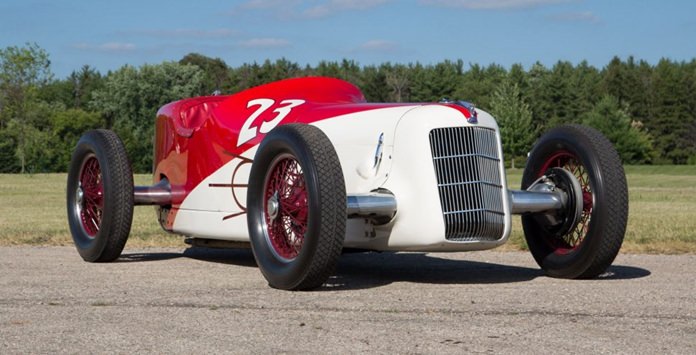Put a celebrated auto engineer and the might of a world manufacturer together and you must get a winning car. The Ford GT40 was born from that sort of thought, as was the Ford Cobra, but it had all been done before.

In 1935, genius race car constructor Harry Miller entered into a deal with Preston Tucker and the Ford Motor Company to produce 10 racing cars that would dominate the Indianapolis 500. Miller created arguably the most beautiful and advanced racing car of the day, but victory wasn’t in the cards, and Ford’s subsequent public humiliation at Indy kept the automaker out of racing for decades and nearly bankrupted Miller (though Tucker emerged unscathed).
A reminder of what might have been was seen when one of the 10 Miller Ford V-8 Special Indy Cars constructed for the 1935 race crossed the auction block on Friday, August 19, at Mecum’s Monterey sale.
Being so many years ago, history is somewhat clouded, but the most likely has Preston Tucker contacting Miller with the idea of creating a stock block race car in a fully modern chassis, then pitched the idea to Edsel Ford, not Henry. Even the reported source of the project’s funding differs, with some attributing it to the Ford Motor Company and others crediting a group of Ford dealers.
What is certain is this: In February of 1935, a contract was signed between the Ford Motor Company and a Dearborn supplier named Miller-Tucker, Inc., to design and build a quantity of 10 race cars for the 1935 Indianapolis 500, each priced at $7,500. However, the needed equipment and parts didn’t arrive at the Miller-Tucker shop until March of 1935, giving the business the near-impossible task of designing, building and testing 10 potentially race-winning cars in less than 60 days.
Miller’s design called for front-wheel drive, which he’d utilized in a 1924 racing car based upon the successful 1922 Miller 122. The Miller Fords would also debut four-wheel independent suspension, and in an early attempt at minimizing drag, would use wing-shaped cast aluminum suspension pieces and a (somewhat) streamlined body that ended in a tapered boat tail rear. The lack of a driveshaft meant the Miller Fords could be lower to the ground as well, dropping the center of gravity and enhancing stability in corners.
To use a 21-stud, 220-cu.in. flathead Ford V-8 (rated at roughly 150 horsepower in race trim), Miller turned the engine and two-speed transmission 180 degrees. The layout also moved weight rearward to create a better balanced race car, and on paper, the Miller Fords had everything needed to prove competitive on the track.
Working with such a compressed time frame, Miller had just hours, not days, to test his bold new design. Initially, things looked promising, but in qualifying the Miller Fords proved significantly slower than the competition, and just four of the cars qualified for the 1935 race. Had the cars occupied the front row and the start of the second row, perhaps the pressure on Miller would have been reduced, but instead the Miller Fords began the race in 26th, 27th, 29th and 33rd place, meaning that no car qualified higher than the ninth row, and one qualified dead last.
The results were dreadfully embarrassing for all concerned. The top three retiring before half distance, and the last one finishing 16th.
The common fault was that the steering box was located too close to the engine, and heated to the point where the grease melted and the gears expanded, locking the steering wheel in driver’s hands.
In the aftermath, Henry Ford reportedly ordered all 10 race cars back to Detroit, where they remained locked away in a warehouse for the next several years.
The Miller Ford auctioned was not described as having raced at Indianapolis, though it is said to be one of the 10 originally built by Harry Miller. Shown at Amelia Island in 2013 in the “Cars of Harry Miller” class, the red over white race car has been awarded an AACA Senior and Race Car Certification, and is eligible for a variety of vintage oval track events.




